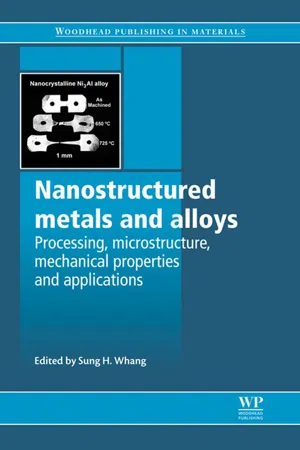Abstract:
Despite its promise, the use of nanostructured metals and alloys as a new generation of structural and functional materials has only recently been realized. Only in recent years has a breakthrough been made in this area, associated both with developing new methods for fabricating bulk nanostructured materials and with investigating the fundamental mechanisms that lead to novel properties in these materials. This chapter presents new concepts and principles in using severe plastic deformation (SPD) techniques to fabricate bulk nanostructured metals with advanced properties. Special emphasis is laid on analysing of the effect of the microstructural features of nanostructured materials fabricated by SPD on mechanical properties such as strength and ductility, fatigue strength and life, and superplasticity, as well as describing early examples of their innovative applications.
1.1 Introduction
The concept of ‘large plastic strains’, or deformations that are characterized by a high value of true accumulated strain (e ≥ 0.5) and are realized at relatively low temperature (≤ 0.4 melting point), is widely used in the branches of physics and mechanics that deal with the problems of strength and ductility of solid states.1−3 Large plastic deformations are actively engaged in practice, for example, in metal forming for shaping in the process of manufacturing semi-products and parts as well as for materials hardening. Traditionally, such methods of metal forming as drawing, extrusion, rolling and others are used for these purposes. Experimental methods for achieving very large strains are usually based on the rolling of strips or thin foils, e.g. with initial thickness of ~ 10 mm up to a final one of ~ 0.1 mm, which is equivalent to a 99% reduction in thickness (true strain e = 4.6). Therefore, true strains 4–4.5 are critical for shaping bulk billets by conventional metal forming methods, and as it was noticed in earlier works, the achievement of larger strains requires radically different processing techniques.4 It was suggested4,5 that such techniques may comprise the die-sets combining shear (torsion) and compression straining as they make it possible to deform the material without changing its form.
Fracture in material is another problem encountered when achieving super-high strains. As is known, many metallic materials are exposed to quick fracture at room temperature even in the early stages of deformation. However, it is possible to increase the deformability of metals and alloys by imposing hydrostatic pressure. The phenomenon was first studied in detail by P.W. Bridgman (Harvard University), who was awarded the Nobel Prize for Physics in 1946 for his works in the sphere of high pressure.6
In the 1980s these ideas were realized by Polish4 and Russian scientists from Yekaterinburg, (formerly Sverdlovsk, USSR)7 in creating experimental die-sets for combined torsion and compression. The application of these devices achieved very large strains with true strains exceeding 8–10, which resulted in strong grain refinement in metals. The basic work was performed by scientists in Ufa in 1988,8 where this method was demonstrated for the first time, of producing ultrafine-grained (UFG) metals and alloys with high-angle grain boundaries that led to new properties. The latter was evidenced by revealing the so-called ‘low-temperature superplasticity’ in an UFG Al alloy. Later, in 1991 UFG materials were first obtained by means of another technique – equal-channel angular pressing (ECAP),9 during which the billet shape is also preserved and therefore very large strains are achieved by multi-pass processing. As demonstrated below, ECAP allows the production of UFG structures in bulk billets from different metals and alloys. Moreover, the technique is very promising for practical applications. This new approach to grain refinement, based on the achievement of very large true strains with e ≥ 6–8 under high pressure, was termed ‘severe plastic deformation’ (SPD)10 and attracted much attention with the further development of many SPD techniques.11−13 Besides, SPD processing routes and regimes for grain refinement were established for various metals and alloys.14 More complete definitions of SPD processing and ultrafine-grained (UFG) materials are presented in several recent overviews.11,12,15,16 It is important to emphasize that SPD-produced UFG materials are fully dense and their large geometric dimensions make it possible to study their properties thoroughly by means of mechanical and other tests. As a result, the subject of bulk ultrafine-grained materials produced by severe plastic deformation was introduced into scientific literature. The next important step along with the formation of UFG was finding nanostructural features in SPD-processed metals (non-equilibrium grain boundaries, dislocation substructures, segregations and nanoparticles and other elements) resulting in novel properties16 (see also section 1.3.3, this chapter). At this time, the fabrication of bulk nanostructured materials by SPD is becoming one of the most actively developing areas in the field of nanomaterials.12,17
The present chapter considers new trends in the development of SPD techniques, basic requirements for processing nanostructured materials with enhanced properties by means of SPD, and prospects for their practical applications.
